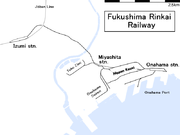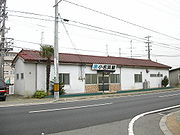
Fukushima Rinkai Railway Main Line
Encyclopedia

Izumi Station (Iwaki, Fukushima)
is a railway station located in Iwaki, Fukushima Prefecture, Japan, opertaed by East Japan Railway Company .-External links:*...
, serving Onahama Freight Terminal, all in Iwaki, Fukushima
Iwaki, Fukushima
is a city located in the southern part of the Hamadōri coastal region of Fukushima Prefecture, Japan.A designated "core city", Iwaki is also one of the growing number of hiragana cities. Its area is 1,231.35 km², making it the 10th largest city in Japan...
. It is the only railway line operated by the , excluding a few more industrial railway
Industrial railway
An industrial railway is a type of railway that is not available for public transportation and is used exclusively to serve a particular industrial, logistics or military site...
lines. The third sector company had its roots as a horsecar
Horsecar
A horsecar or horse-drawn tram is an animal-powered streetcar or tram.These early forms of public transport developed out of industrial haulage routes that had long been in existence, and from the omnibus routes that first ran on public streets in the 1820s, using the newly improved iron or steel...
operator, opened in 1907 to transport salt and fish. On the development of the Port of Onahama industrial area it changed to a railway line carrying zinc
Zinc
Zinc , or spelter , is a metallic chemical element; it has the symbol Zn and atomic number 30. It is the first element in group 12 of the periodic table. Zinc is, in some respects, chemically similar to magnesium, because its ion is of similar size and its only common oxidation state is +2...
and containers
Containerization
Containerization is a system of freight transport based on a range of steel intermodal containers...
. It had a passenger service until 1972.
Basic data
- Distance: 5.4 km / 3.4 mi.
- GaugeRail gaugeTrack gauge or rail gauge is the distance between the inner sides of the heads of the two load bearing rails that make up a single railway line. Sixty percent of the world's railways use a standard gauge of . Wider gauges are called broad gauge; smaller gauges, narrow gauge. Break-of-gauge refers...
: - Double track line: None
- Electrification: None
- Railway signallingRailway signallingRailway signalling is a system used to control railway traffic safely, essentially to prevent trains from colliding. Being guided by fixed rails, trains are uniquely susceptible to collision; furthermore, trains cannot stop quickly, and frequently operate at speeds that do not enable them to stop...
: TabletToken (railway signalling)In railway signalling, a token is a physical object which a locomotive driver is required to have or see before entering onto a particular section of single track. The token is clearly endorsed with the name of the section it belongs to...
token
Stations

| Station/Freight terminal | Japanese | Distance (km) | Transfers | Location |
|---|---|---|---|---|
| Izumi Izumi Station (Iwaki, Fukushima) is a railway station located in Iwaki, Fukushima Prefecture, Japan, opertaed by East Japan Railway Company .-External links:*... |
泉 | 0.0 | Jōban Line Joban Line The is a railway line in Japan operated by East Japan Railway Company . It begins at Nippori Station in Taitō, Tokyo and follows the Pacific coasts of Chiba, Ibaraki, and Fukushima Prefectures before the line officially ends at Iwanuma Station in Iwanuma, Miyagi... |
Iwaki, Fukushima Iwaki, Fukushima is a city located in the southern part of the Hamadōri coastal region of Fukushima Prefecture, Japan.A designated "core city", Iwaki is also one of the growing number of hiragana cities. Its area is 1,231.35 km², making it the 10th largest city in Japan... |
| Miyashita Freight Terminal | 宮下 | 3.6 | ||
| Onahama Freight Terminal | 小名浜 | 5.4 |

